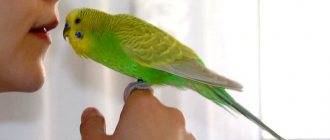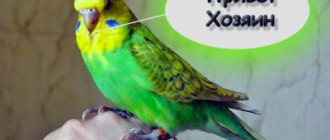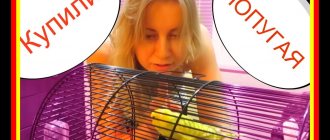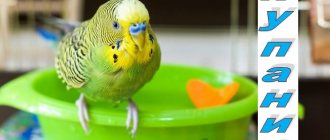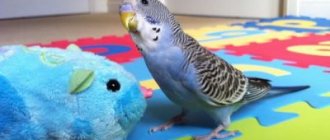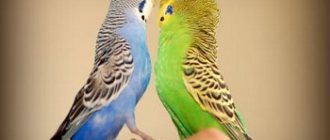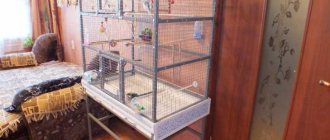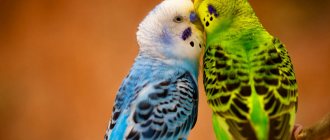In nature, budgies bathe whenever they want: they take a “shower” during the rain, splash in puddles, and water their feathers in wet grass. But is it worth washing a tame bird that lives in a cage? First of all, you should take a closer look at your pet and understand whether it needs bathing. You can help keep budgies clean at home; many ways have been invented for this.
Is it possible to bathe and is it necessary to do so?
If you observe the behavior of birds in nature, you can say with confidence that they are extremely favorable towards water procedures.
Even wild pigeons and sparrows, which are common in urban environments, splash with great pleasure in puddles after the rain.
Parrots are no exception in this case. Their natural habitat is the moist forests of the tropical and equatorial climatic zones. In the wild, wavy moths wash in puddles after rains, as well as in dew that forms on the grass.
Bathing is an important hygiene procedure for birds. In this way they clean their plumage of dirt and parasites. In addition, bathing is necessary on hot days, and it simply gives the parrot great pleasure.
When feathered pets are kept in city apartments, they also need to be washed periodically. However, certain nuances related to the peculiarities of their home maintenance should be taken into account.
Clean water without impurities should be used for bathing. The use of cleaning products is unacceptable, except in cases of severe contamination of the bird's plumage.
It should be remembered that parrots are quite independent and can easily perform the hygiene procedures they need on their own. For the owner of the bird, first of all, it is necessary to organize and provide appropriate and suitable conditions for this.
It is also useful to read: Where to put a cage with a parrot
Frequency of bathing
There are quite a lot of recommendations on how often a parrot should take water treatments at home, but a responsible owner should be guided, first of all, by the mood and state of health of his pet.
Parrots are quite intellectually and emotionally developed pets, and each of them can have its own unique character. Some of them will take water procedures with joy and eagerness, when others will shy away from them.
You cannot force a bird to bathe. If the parrot resists washing or does not go to the bath, then the procedure should be postponed until a more favorable moment.
In addition, you should remember that you should not bathe your parrot immediately after purchase. Moving to a new home is a great stress for the bird, which reduces immunity, and therefore the pet may even get sick. After purchasing, you should wait at least 2 weeks before performing the first water procedure.
Is it worth getting a parrot?
Not really
The owner of a feathered pet should also remember that bathing, in addition to being beneficial, can also cause harm to the bird. Thus, experts do not recommend arranging water treatments for a sick pet. Only healthy and active parrots can be bathed. If the pet shows signs of ill health, then it must be shown to a specialist.
The time of year also plays a big role in determining the frequency of bathing.
So, in the summer it is recommended to wash the bird no more than once a week . However, exceptions are allowed when the pet is in a hot and dry room. In this case, the pet is bathed every other day. But you should remember that parrots can take care of themselves on their own, and not get carried away by constantly forcing them to perform water procedures.
In the winter season, many parrot owners do not bathe them at all . This is due to the fact that possible drafts, low air temperature in the room, as well as short daylight hours negatively affect the immunity of the feathered pet.
Frequent bathing in this case can lead to illness. However, if the bird still likes to swim, and the room where it is constantly located is well heated, and there are no drafts, then it is allowed to bathe the parrot no more than once every 2 weeks.
Make it rain lightly
Fourth, fill a spray bottle with hot water and spray it over the parrot's head . Do this carefully and do not spray water directly on the bird itself, otherwise the parrot will get scared and your efforts will end in nothing.
But if you acted correctly, then gradually your feathered pet will really like such a light “shower”, and you will be able to spray water so that some of it falls on the wings and tail.
How to bathe a bird at home
There are quite a few ways to organize water treatments for a budgie at home. Let's look at the most popular ways to bathe a bird:
In the bath
Today, in any pet store you can purchase a special plastic bath for parrots.
It is easily attached to the cage (outside or inside it) and does not take up much space. Sometimes the bathhouse is sold complete with a cage.
When choosing a bath, preference should be given to closed models. The fact is that when bathing, parrots actively spray water around them, and therefore they can wet the space inside the cage.
Sometimes the baths are quite deep, but the parrot does not need a lot of water for swimming. It is enough for it to cover the bottom of the tank by 1-2 cm.
It should be noted that not all pets may like this type of water treatment. In this regard, it is recommended to put a toy in the bath, and after bathing, reward the bird with a treat.
Parrots are social pets that need communication with both their owner and their own kind. Some kind of replacement for the latter can be a small mirror, in which the parrot can perceive its own reflection as another bird. If you put a mirror in the bath, your pet will be more willing to take water procedures in the presence of his “double”.
Spray bottle
This method is suitable when the pet flatly refuses to bathe in the bath. In addition, with the help of a spray bottle you can introduce even the most cautious and tame parrots to water procedures.
The water used for bathing must be warm. The ideal temperature is around 25 degrees Celsius. For the first time, you do not need to spray water directly on your pet. It's better to do it on top of it. This “rain” does not injure the bird at all and allows it to get used to the water.
Then you can direct the stream at the parrot itself, while carefully monitoring its reaction. If the pet reacts to it calmly, then this type of bathing can become the main one.
The duration of water procedures using a spray bottle should not be more than 20-30 minutes.
If your pet is in a cage while bathing, then you need to remove the feeder from there.
Under the tap
Many parrots love running water and will happily bathe under the tap. However, it should be remembered that such bathing should take place in the owner’s hands under a small thin stream of water.
Sand
In cases where the bird cannot tolerate water procedures, it is possible to wash the parrots with sand. It perfectly helps your pet cope with various plumage contaminants.
Only special mineral or sea sand should be used. River sand contains many impurities, as well as parasite larvae, so its use can lead to illness in your pet.
Wet grass
At the beginning of the article it was mentioned that in the wild, parrots bathe in dew that forms on the grass. This method can also be used at home.
To do this, you need to sprinkle the grass or leaves with a small amount of water , after which you should put them in the cage.
If the pet starts playing with it, then the bathing process will go unnoticed both for itself and for the owner.
Detergents
Experts strongly recommend against washing parrots using cleaning products. However, this is allowed in the case of significant contamination, in which water alone is not enough.
Detergents should be understood as shampoo or shower gel. It is desirable that they contain as little chemical fragrances and dyes as possible.
When bathing with shampoo, it is important to apply the product only to the area where there is contamination. In this case, it is not necessary to bathe the bird entirely. Afterwards, rinse thoroughly with warm running water. It is important that no traces of shampoo or other detergent remain on the plumage.
It is also useful to read: How to tame a parrot to your hands
Peculiarities
The owner of a bird needs to know how to bathe a bird without consequences. To do this, you should know some prohibitions and taboos for bird water procedures.
- Bathing budgerigars should take place in specially sized baths. Containers that are too large and deep, intended for larger birds, can become a source of danger for small birds.
- The room should be warm and dry. When swimming, birds indoors close all windows and doors.
- If bathing takes place in a bathtub or sink, there should be an owner nearby who knows how to wash the bird without consequences.
- After the budgie has bathed, it should not be dried. The bird will dry itself naturally, and using a hairdryer or fireplace will only harm the bird’s skin. Also, after buying budgies, it is not recommended to dry them with a hard towel - this can ruin the plumage.
Note: the water in the bath should always be warm, especially in the cold season.
The owner of the bird needs to know how to bathe a budgerigar easily and without consequences at home. This knowledge is necessary for a person to create the right living conditions for a feathered friend. It is impossible to force a budgie to bathe, but there are many ways to teach it to love water. Water procedures are the key to a healthy and happy life for a motley parrot. Watching the water games of feathered pets will bring a lot of positive emotions to their owner.
What rules should you follow when swimming?
When bathing, almost regardless of the method, the following important rules must be observed:
- No drafts. Parrots have rather poor health, so the presence of drafts during bathing can lead to illness in the bird.
- No additives in water . It is advisable to bathe pets in plain drinking water. The use of chlorinated water from a tap or untreated water from a natural reservoir is unacceptable.
- Optimal temperature of water and air in the room. Bathing water should be warm (about 25 degrees Celsius). The same applies to the air temperature in the room, which should be at least 18 degrees.
- Pet's condition . You can only bathe parrots that are absolutely healthy. Any illness is a contraindication to taking water procedures.
If a bird does not want to swim, how to accustom it to water procedures
The first time, as a rule, the parrot refuses to bathe for the reason that it is afraid of water procedures. In this case, the owner of the bird should be patient.
Under no circumstances should a bird be forced to undergo the procedure . This will make the parrot afraid of water even more.
So, if we are talking about water procedures in a bathhouse, you first need to accustom the bird to this subject.
To do this, you should leave it empty, putting a toy or treat there. When the pet gets used to the bath, it is allowed to fill it with water. After a certain time, the parrot will no longer be completely afraid of water and related procedures.
To teach a bird to bathe under a tap, you need to periodically bring your pet close to it for a short time so that it can get used to the sound of the water, and only then move it closer to the stream.
Under the tap
First, turn off the faucet in the kitchen or bathroom and adjust the pressure (the stream should be thin). Now take the bird in your arms and carefully bring it to the stream of water. Take your time - the parrot should take a close look at the running liquid. He will first try to grab the water with his beak, and then he will crawl under the soft and gentle stream.
By the way, if your bird likes this procedure, then you will have to constantly give her such baths.

